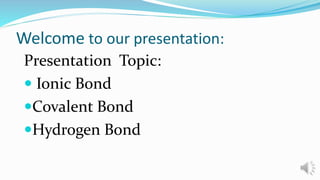Ionic bond,covalent bond and hydrogen bond
•Transferir como PPTX, PDF•
40 gostaram•9,056 visualizações
Ionic bond,covalent bond and hydrogen bond . we can see from this slide the definition and mechanism of those chemical bonding eaily
Denunciar
Compartilhar
Denunciar
Compartilhar

Recomendados
Recomendados
Mais conteúdo relacionado
Mais procurados
Mais procurados (20)
Destaque
Destaque (20)
Notes on 3.2 properties of linear frunction graphs

Notes on 3.2 properties of linear frunction graphs
The Use of Montomorillonte as an absorbent for ignitable liquids from porcine...

The Use of Montomorillonte as an absorbent for ignitable liquids from porcine...
Semelhante a Ionic bond,covalent bond and hydrogen bond
Semelhante a Ionic bond,covalent bond and hydrogen bond (20)
Class 11 Chemistry Revision Notes Chemical Bonding and Molecular Structure.pdf

Class 11 Chemistry Revision Notes Chemical Bonding and Molecular Structure.pdf
Último
Último (20)
Call Girls Alandi Call Me 7737669865 Budget Friendly No Advance Booking

Call Girls Alandi Call Me 7737669865 Budget Friendly No Advance Booking
Introduction,importance and scope of horticulture.pptx

Introduction,importance and scope of horticulture.pptx
Feature-aligned N-BEATS with Sinkhorn divergence (ICLR '24)

Feature-aligned N-BEATS with Sinkhorn divergence (ICLR '24)
Formation of low mass protostars and their circumstellar disks

Formation of low mass protostars and their circumstellar disks
9654467111 Call Girls In Raj Nagar Delhi Short 1500 Night 6000

9654467111 Call Girls In Raj Nagar Delhi Short 1500 Night 6000
dkNET Webinar "Texera: A Scalable Cloud Computing Platform for Sharing Data a...

dkNET Webinar "Texera: A Scalable Cloud Computing Platform for Sharing Data a...
Dopamine neurotransmitter determination using graphite sheet- graphene nano-s...

Dopamine neurotransmitter determination using graphite sheet- graphene nano-s...
Asymmetry in the atmosphere of the ultra-hot Jupiter WASP-76 b

Asymmetry in the atmosphere of the ultra-hot Jupiter WASP-76 b
Ionic bond,covalent bond and hydrogen bond
- 1. Welcome to our presentation: Presentation Topic: Ionic Bond Covalent Bond Hydrogen Bond
- 2. IONIC BONDING: Ionic bonds are a type of chemical bond based on electrostatic forces between two oppositely-charged ions. It is basically the transfer of one electron from one atom to another
- 3. Characteristics of Ionic bonding: It is formed by transfer of electron It is formed between a metal and a nonmetal atom Consists of electrostic force between (+) and (-) ions Mechanism of Ionic bond: According to the octet theory when an atom takes part in a chemical bonding it tends to be more stable like the Nobel gas . For that they need to fill with 8 electrons at its valance shell. As Ionic bond made by the transfer of electrons ,the atoms which took part in the bonding neither it will lose electron or gain electron. Metals have 2-3 electrons at valance shell it is easy for them lose electron & non metal are very suitable at electron gaining. After losing electron the metal turns into (+) ion and after gaining electron non metal become (-) ion. The electrostic force between (+) and (-) ions create the Ionic bonding.
- 5. In real life we can see this example:
- 6. Covalent bond: This type of chemical bonding is made of Sharing of electrons among the atoms. The Sharing of electrons equal among the atoms.
- 7. Characteristics of Covalent bonding: It is made by sharing of electron It is formed between non-metal atoms It is consists of a shared pair of electrons between atoms Mechanism of covalent bonding: In covalent bonding atoms still want to achieve a noble gas configuration. But rather than losing or gaining electrons atoms now share an electron pair. The shared electron pair is called a bonding pair electrons.
- 8. Chlorine molecule Cl2 Molecules have no overall electric charge Molecular or covalent compounds are usually gases or liquids – they have low melting points and low boiling points Forces between molecules very weak Forces (bonds) between atoms in the molecule very strong Each outer shell has 8 electrons Electrons shared
- 9. It can be shown as:
- 10. Hydrogen bonds A hydrogen atom covalently bonded to an electronegative atom … N, O or F. . A lone pair of electrons on the electronegative atom takes part in bonding with Hydrogen
- 11. Types of Hydrogen bond: Intramolecular Hydrogen bond: It occurs with in one single molecule.Example: C2H4(OH)2 Intermolecular Hydrogen bond: It occurs Between separate molecules.Example:NH3,H2O
- 12. Factors preventing Hydrogen bonding Electronegativity Atom Size
- 13. Hydrogen bonds In Water:
